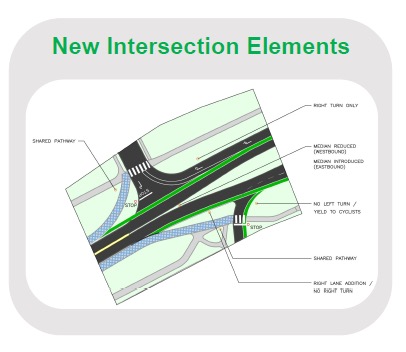Most Outstanding Poster Award at Design + Innovation Day 2023
Design + Innovation Day is UBC Engineering’s annual showcase for student engineering design projects.
Carried out in small groups over the previous academic year, the projects enable students to improve their technical, teamwork and management skills while designing solutions to real-world problems.
The Department of Civil Engineering recognizes the most outstanding Design and Innovation Day poster, rated by client impact, teamwork, creativity and communication.
Community Partner: UBC Social Ecological Economic Development Studies (SEEDS)
Degree: Bachelor of Applied Science
Program: Civil Engineering
Campus: Vancouver
The Challenge
There’s a busy area of West 16th Avenue between Wesbrook Mall and Blanca Street where drivers frequently exceed the posted speed limit of 50 kilometres per hour and there are no protected crossings for pedestrians and cyclists. UBC SEEDS asked us to come up with a design that provided a safe, accessible, and grade-separated crossing; offered an efficient water management system; improved cyclist safety; and minimized tree removal.
Our inspiration
We did a lot of research on best practices used elsewhere. We spent some time at the site observing how people – including children attending Norma Rose Point Elementary School – used the crossing. There were some obvious safety issues: the current design is an at-grade crossing with a pedestrian-controlled flashing beacon, but pedestrians can’t actually see if the light is working from where they stand to activate the button. They also have to activate the flashing light again once they’ve reached the median, which isn’t intuitive.
Our design process
It’s been very iterative and we’ve made changes to our design along the way as new information or ideas came along.
In the first term, we began with developing three conceptual designs. We evaluated these designs against a weighted decision matrix that enabled us to identify the solution that best met all the project criteria. In the second term, we moved to the detailed design phase to develop our concept even further. Throughout the process we attended review meetings with the client to get feedback on our process.
Our proposed solution
Our road design includes an elevated bridge that spans 184 metres, with one lane in each direction for vehicles. Our bridge structure consists of a composite reinforced concrete over steel deck, structural steel frame, 16 reinforced concrete footings and two reinforced concrete abutments. Stepped precast reinforced concrete retaining walls support the excavated areas. On the water management design side, we generated a digital elevation model based on an analysis of site hydrology to understand overland storm flow routes. We then designed a catchment basin and distribution pipeline to collect runoff from impervious surface and designed an infiltrating swale to discharge collected stormwater into the ground.

Our project also included a four-phase construction plan stretching over three-and-a-half months, which incorporated a traffic management plan for the construction period and the identification of risks and their proposed mitigations. We went beyond the initial project scope to incorporate Indigenous artwork and suggest enhanced landscaping and the use of permeable pavement. Although we were not given a defined budget for this project, our estimation of costs, including contingency, is that it would cost $10.2 million to complete the work.
Our design process
“SEEDS is hoping that our work might show proof of concept and could perhaps be integrated into a new approach to the site.”
In the first term, we began with developing three conceptual designs. We evaluated these designs against a weighted decision matrix that enabled us to identify the solution that best met all the project criteria. In the second term, we moved to the detailed design phase to develop our concept even further. Throughout the process we attended review meetings with the client to get feedback on our process.
What we learned
It was fascinating to see how the design progressed from term one to term two and how we each contributed expertise in different areas. It was also interesting to be applying knowledge we’d acquired over the course of our degree. For example, one of the first things we learned in first year was how to use a weighted decision matrix to select the optimum solution for a project. This project also introduced us to codes that we weren’t as familiar with – while we’ve worked a lot with the building code, the Canadian Highway Bridge Design Code was relatively new.
Our project’s future
Our understanding is that our client, UBC SEEDS, might share our work with a broader group of stakeholders to try and influence them to take action and improve this particular area by providing a safe crossing point for pedestrians and cyclists.
